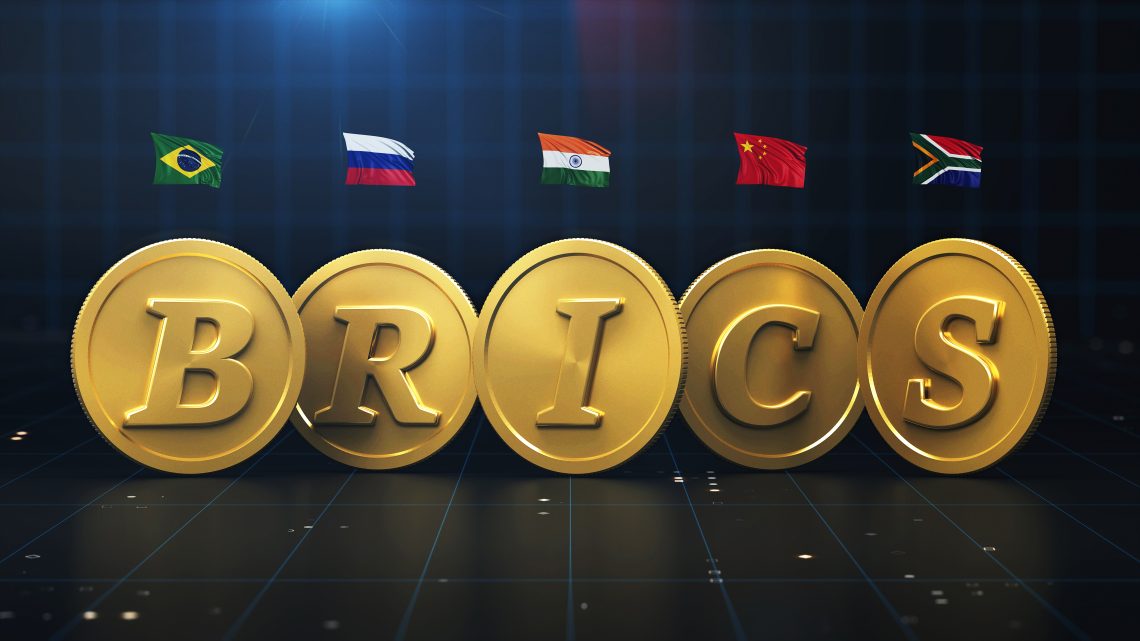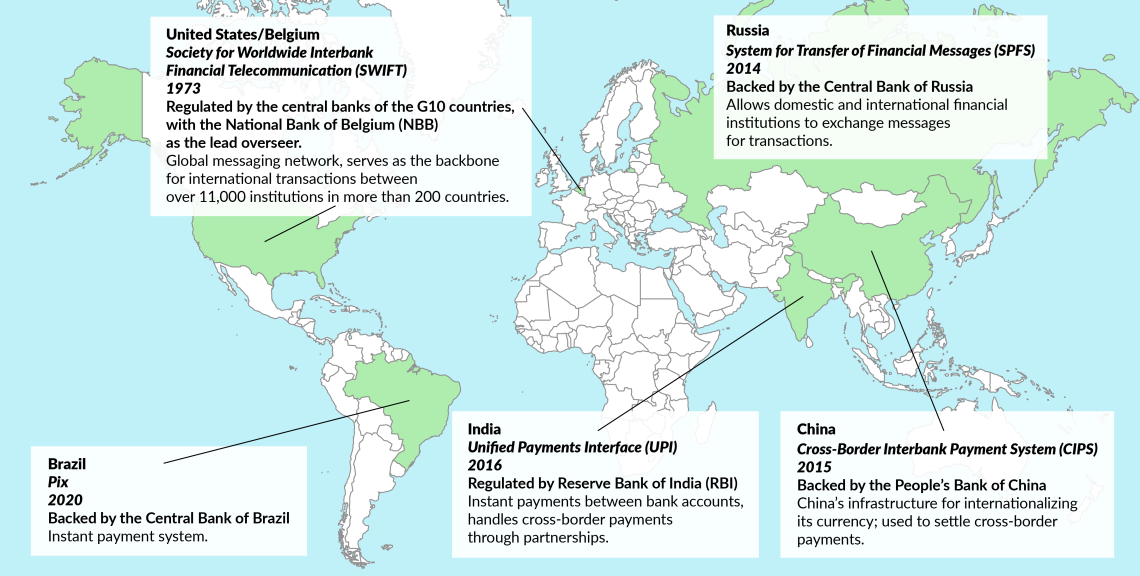BRICS making incremental progress in dollar-free trade
The development of a non-Western payment system is gathering pace.

In a nutshell
- A BRICS-led payment system aims to rival SWIFT
- Technical and political disparities hold back implementation
- An interoperable system linking national networks may be feasible
- For comprehensive insights, tune into our AI-powered podcast here
The growing influence of countries motivated to challenge the dominance of Western financial systems, particularly global reliance on the United States dollar, may result in a new financial network that leaves Washington on the sidelines.
The BRICS group, originally composed of Brazil, Russia, India, China and South Africa, has expanded significantly in recent years to include Egypt, Iran, the United Arab Emirates, Ethiopia and Indonesia. Together, these nations represent roughly 45 percent of the world’s population and 35 percent of global gross domestic product.
Their motivation to challenge Western financial dominance is multifaceted. It includes a desire for greater financial sovereignty, reduced exposure to U.S. sanctions and the promotion of a multipolar global economic order. Central to this effort is the development of a BRICS payment system that can facilitate cross-border transactions in local currencies, reducing dependence on SWIFT and bypassing the U.S.-dominated global financial system.
Yet such a major undertaking faces significant challenges, including the bloc’s own difficulties in coordinating among participant states as well as threats from President Donald Trump, who opposes efforts that undermine the U.S. dollar’s dominance.
A BRICS payment system: Motivations and progress
The American dollar has long been the world’s primary reserve currency, accounting for nearly 60 percent of global foreign exchange reserves as of 2024.
However, BRICS nations have grown increasingly wary of their dependence on the dollar’s status, particularly after the U.S. used its financial power to impose sanctions on Russia and Iran. The freezing of Russian foreign reserves following the country’s 2022 invasion of Ukraine was a reminder to Global Majority countries of the risks associated with reliance on dollar-based systems.
In response, Moscow, Beijing and other like-minded countries have been exploring the development of the BRICS Pay initiative to escape reliance on U.S. financial dominance. It is being designed as a decentralized cross-border financial messaging system that enables transactions between BRICS nations using their national currencies. This includes encryption, distributed consensus nodes, multi-factor authentication and the technical capacity to process up to 20,000 messages per second.
Importantly, it does not require mandatory transaction fees and is being developed as an open-source protocol, ensuring that each country can run its own node while remaining interoperable with others. It also seeks to integrate various national platforms that already exist or are in development.
Facts & figures
Payment systems around the world

Russia’s System for Transfer of Financial Messages (SPFS), China’s Cross-Border Interbank Payment System (CIPS) and UnionPay network, India’s Unified Payments Interface (UPI) and Brazil’s Pix system form the technical and policy backbone of this approach. The interoperability of these platforms is essential for creating a cohesive BRICS-led payment infrastructure that can rival SWIFT in scope and reliability, albeit within a more limited geographic and political bloc.
A prototype demonstration of BRICS Pay was showcased in Moscow in October 2024, marking a technical milestone in the project’s progress. Despite this, as of mid-2025, the system remains in its planning and early pilot stages, with hopes for broader operational deployment by the end of this year or into 2026. Integration efforts are progressing slowly, with secure links between Russia’s SPFS and other countries only partially implemented, and much work still needed on standardized messaging protocols and cybersecurity frameworks.
Currently, no fully unified BRICS payment system exists. Russia’s SPFS and China’s CIPS serve as the main alternatives to SWIFT. China’s digital yuan and Brazil’s digital real suggest a move toward blockchain-based settlements, which could be incorporated into a BRICS framework. The expansion of BRICS to include countries with large economies like Indonesia or sophisticated offshore financial centers such as the UAE opens up additional opportunities for users of the BRICS payment system.
Technical and infrastructure hurdles
Even if these technical and political challenges are overcome, BRICS still faces the massive hurdle of confronting the entrenched dominance of the U.S. dollar. The dollar is not only the world’s most used currency for trade and reserves, but it is also embedded in institutional stability and liquid capital markets that BRICS countries currently lack. There is no unified monetary policy among the non-Western countries, no shared capital market and no single central bank capable of underwriting a collective BRICS financial system like the Federal Reserve backs the American financial ecosystem.
The development of BRICS Pay represents not only a technological project but also a deliberate move to foster a multipolar financial world order.
Nevertheless, the BRICS nations have begun to pursue alternative approaches that allow them to gradually sidestep dollar dependency. One such strategy is the increasing use of local currencies in bilateral trade. Russia, for instance, reported in 2024 that 90 percent of its trade within the BRICS bloc was conducted in national currencies rather than dollars. China and India have engaged in rupee-yuan trade agreements, and Brazil has initiated similar arrangements using its real.
While these developments are significant, they do not yet amount to a coordinated assault on the dollar’s supremacy. Experts across various financial institutions estimate that a fully functioning and trusted alternative to SWIFT or the U.S. dollar is probably decades away, if it can be achieved at all.
Even so, the geopolitical implications of these incremental steps cannot be understated. The development of BRICS Pay represents not only a technological project but also a deliberate move to foster a multipolar financial world order.
Complications within BRICS itself
The internal dynamics of the BRICS nations pose significant challenges to the rapid implementation of the payment system. While Russia and China have been strongly motivated to reduce their dependence on the U.S.-dominated financial system – especially due to Western financial sanctions and export controls that mainly target them – India, Brazil and South Africa have traditionally taken more cautious positions.
India, though enthusiastic about bilateral trade in local currencies, has carefully calibrated its relations with Western financial institutions and has been wary of fully aligning with the more politically assertive stances taken by China and Russia.

Brazil, like India, has been pragmatic. Instead of pushing for a common BRICS currency, a concept floated at various BRICS summits but repeatedly deferred, it has focused on interoperable digital payment systems while expanding its national Pix platform. Economist Paul Krugman described Pix as a model of democratic financial innovation, yet it has faced scrutiny from the U.S. financial sector, with credit card companies and banks viewing it as disruptive. Some investigations into Pix are seen as politically motivated attempts to undermine the country’s growing independence in financial technology.
South Africa has also, in the past, voiced concerns over moving too quickly toward de-dollarization, warning that it could harm existing economic partnerships and investment flows with the U.S. and the West in general.
Political challenges from Washington
Political pressure from Washington has complicated the adoption of a BRICS payment system. President Trump has issued multiple threats of punitive tariffs and economic sanctions aimed directly at BRICS members participating in what he calls “anti-American” currency or payment initiatives.
In one of his declarations, President Trump promised to impose 100 percent tariffs on any nation adopting a joint BRICS currency, along with an additional 10 percent tariff on those countries introducing initiatives that he deems hostile to U.S. interests. These statements, while dismissed by some as political grandstanding, have had tangible effects. They have increased political risk for countries considering deeper integration into BRICS Pay or alternative trade systems and have drawn sharp criticism from international trade experts who warned that such policies could trigger a backlash against the dollar itself.
However, the political challenges to several BRICS nations – such as U.S. tariffs of 50 percent on India for its purchases of Russian oil − have pushed them closer to, rather than away from, adopting a new financial architecture.
These developments have heightened the sense of urgency in New Delhi to more rapidly and extensively consider how to reduce its reliance on the U.S. economy and American global financial dominance. As an immediate response to Mr. Trump’s secondary tariffs, Prime Minister Narendra Modi approved ongoing purchases of discounted Russian oil by the country’s private refiners. Later in August, he made his first visit to China since 2018, following the violent clash between the two countries’ militaries in the Galwan Valley in 2020.
Read more on BRICS
- Turkey, BRICS and a multipolar world order
- Cracks in the global monetary system: IMF and BRICS
- Trump and the allure of BRICS: A Southeast Asian perspective
Brazil has also been subjected to 50 percent U.S. tariffs. President Trump has accused the Brazilian government of taking actions that harm American Big Tech companies. He has also stated that Brazil’s judiciary is involved in a politically motivated campaign against Jair Bolsonaro, former Brazilian President and political rival of President Luiz Inacio Lula da Silva (and Trump ally). President Lula’s response was to have a telephone conversation on August 11 with Chinese President Xi Jinping, one that may serve as a springboard to bolster financial ties, including working together at the BRICS level to challenge U.S. economic power.
Washington’s recent imposition of 30 percent tariffs on South African exports, the highest for any African state, has pushed the country to look at measures to help it limit exposure to U.S. financial power, especially through BRICS partnerships. Meanwhile, Pretoria will continue efforts to seek a trade deal with the Trump administration to mitigate the impact of the tariffs.
While internal differences within the BRICS group had previously hindered the practical implementation of measures to de-dollarize and seek alternatives to U.S. financial dominance, there is now a significant uplift in political appetite for reducing reliance on the U.S. financial system. As a result, the Global Majority states of India, Brazil and South Africa now seem more assured than in the past to closely align with China and Russia in pursuing an alternative global financial architecture.
The focus has shifted from the overly ambitious goal of launching a shared BRICS currency to more feasible targets: increased bilateral trade in national currencies, strengthening alternate payment systems and slowly building the BRICS Pay messaging system for inter-bloc transactions.
Scenarios
Most likely: Fragmented interoperability with regional strength
While BRICS Pay embodies more of a long-term strategic shift rather than a sudden disruption to the U.S.-dominated financial architecture, it reflects a strong desire among member countries to assert financial sovereignty and challenge Western management and ownership of global finance.
Threats from President Trump may now have gone too far in assaulting the sovereignty and economic fortunes of all the main BRICS nations, to the point where their disparate ambitions lead to a more unified front. His actions could therefore prove inadvertently galvanizing, leading to an era where unchallenged dollar dominance faces its most serious tests since the end of the Cold War.
BRICS Pay is unlikely to see full implementation within the year. What is more realistic is an expansion of regional test projects and increased policy alignment among the core members.
Developments over the medium term may lead to the creation of a fragmented but interoperable system that links national payment infrastructures rather than replacing them with a single currency or centralized system. For example, Russia’s SPFS, China’s CIPS and India’s domestic payment networks could become interconnected via standardized protocols or settlement corridors, allowing cross-border trade and financial messaging in local currencies. Pilot programs for cross-border settlements in local currencies have already occurred between Russia and China and India and the UAE, suggesting momentum is building.
This approach avoids the immense political and technical difficulties of establishing a unified digital currency or clearinghouse, while still working toward BRICS’s goal of de-dollarization. However, due to differing regulatory approaches, currency convertibility issues (notably with the Chinese yuan and Indian rupee) and competing national interests, the system will likely remain heavily reliant on bilateral agreements for several years.
Less likely: Fully unified BRICS currency and centralized payment system
A less likely but more transformative outcome would be the launch of a centralized BRICS digital currency and a supranational payment system like a BRICS version of the Eurozone’s TARGET2 – a real-time settlement system for processing euro-denominated payments. In this scenario, BRICS countries would agree on a new settlement currency, possibly backed by a basket of member currencies or commodities like gold.
While this would represent a dramatic challenge to the U.S.-led global financial order, it faces major hurdles. Different inflation rates, economic structures and political priorities among member states make monetary integration extremely complex. China and India, in particular, have competing visions of regional influence and are unlikely to surrender monetary sovereignty. Moreover, smaller or newer BRICS members may be wary of becoming dependent on a currency controlled by China or Russia.
The level of trust and institutional maturity required to manage a shared monetary system does not yet exist, making this an improbable path in the near future.
Possible: Parallel BRICS token for trade settlement
The bloc could introduce a non-sovereign, blockchain-based BRICS trade token; not a currency, but a unit of account used for settlement in trade and finance between member countries. Such a token could be pegged to a commodity basket or a neutral index to prevent domination by any single country. It would function more like the International Monetary Fund’s Special Drawing Rights (SDRs) but within a BRICS framework.
This solution would allow BRICS to bypass the dollar without the political complications of a single shared currency. It would require a new financial institution or consortium to manage issuance, transparency and regulation of the token. The success of this approach would hinge on wide adoption, technological robustness and trust in the system’s neutrality.
This alternative would be attractive for countries wanting a middle path, one that is more integrated than bilateral trade deals, but less radical than a shared currency.
Contact us today for tailored geopolitical insights and industry-specific advisory services.







